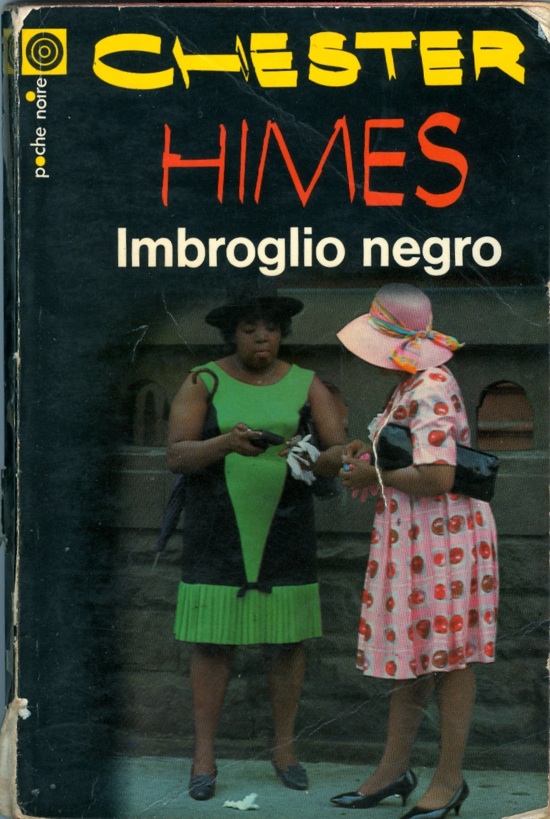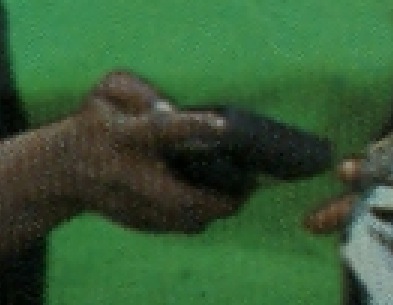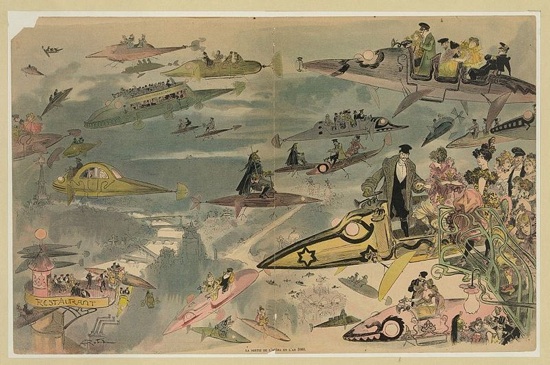Pluperfect PDA (1)
By:
September 25, 2009

Yesterday, my friends at Pazzo Books sold me the 1960 French edition (“traduit de l’Américain” — that’s hilarious) of Chester Himes‘ Imbroglio negro (published in America, that same year, as All Shot Up), shown above. It’s a noir novel featuring Himes’ black Harlem cop characters Ed Cercueil (Coffin Ed Johnson) and Fossoyeur (Grave Digger Jones). I already knew that French culture was more advanced than ours, in those days. That’s why Himes chose to live and work in France; and it’s why the French embraced Poe, Dick, and Lewis. But who knew that French technology was so much more advanced than ours?

Yes, that’s right. Your eyes aren’t deceiving you. The Harlem matron in green pictured on the cover of Imbroglio negro is scrolling through emails — or perhaps texting — on what can only be an Internet-connected, multimedia smartphone. Just look at her hand position — she’s in danger of developing BlackBerry Thumb! We know there weren’t smartphones in the US, back in 1960 — so this photo must have been shot in Paris, using American-style models and fashions.
Ringtone: “The Twist”

It makes sense that the French beat us to the punch, now that I think about it calmly. Until the 20th century, the French popular imagination was passionately engaged with the future, and future technology; but when Frenchmen like Tocqueville visited America, it was for the purposes of rustification — i.e., in a premodern, agrarian theme park. Rousseau ‘s notion of the Noble Savage? He was talking about Americans.
Cyrano de Bergerac’s The Other World: Comical History of the States and Empires of the Moon described interstellar travel and aliens way back in 1657. Bernard Le Bovier de Fontenelle’s Entretien sur la Pluralité des Mondes appeared in 1686; Americans, around that same time, were reading Cotton Mather’s Memorable Providences, Relating to Witchcratfs and Possessions. (I’m not being entirely fair: Mather also wrote a SF-like treatise arguing that since God would probably not have wanted to waste any space, the Earth was most likely hollow.)

One also thinks of Voltaire’s 1752 SF story Micromégas, Louis-Sébastien Mercier’s L’An 2440 (1771), and so on… through Camille Flammarion’s La Pluralité des Mondes Habités (1862) and Albert Robida’s remarkable Le Vingtième siècle. La vie électrique (1890; illustration, by Robida, shown above). Naturally, we mustn’t leave out Jules Verne’s seminal works of modern SF .
Perhaps the French liked Poe because it was only with Poe’s “Hans Phaall — A Tale,” a moon voyage penned with maximum verisimilitude, that American SF began to catch up to theirs. Now that we have the iPhone, perhaps the French will finally show us a little respect? Je l’espère.
More SF-related posts on HILOBROW.
Other SF-related essays and articles by Joshua Glenn include: “Post-Apocalyptic Kiddie Movies” (Brainiac) | “The Slacktivism of Richard Linklater” (Slate) | “Black Iron Prison” (n+1) | “Back to Utopia” (Boston Globe Ideas) | “In a Perfect World” (Boston Globe Ideas) | “Philip K. Dick: Hermenaut of the Month” (Hermenaut) | “Journeys to the Center ” (New York Times Book Review/IHT) | “Climate of Fear” (Boston Globe Ideas) | “Pulp Affection” (Boston Globe Ideas) | “Eco-Spaceship Redux” (Brainiac) | “Post-Apocalyptic Juvie Lit” (Brainiac) | “Life Imitates Comic Book” (Brainiac) “Vintage Ads of Fictional Futures” (Brainiac) | “Dr. Strange vs. Dr. Craven” (Brainiac) | PS: As the Boston Phoenix pointed out, Joshua Glenn beat every other media outlet in Boston to the scoop that the Mooninite Invasion of 2007 was just a guerrilla marketing campaign.
SIMILAR HILOBROW SERIES: DOUBLE EXPOSURE — the stratagems of Middlebrow | EGGHEAD — a gallery | FITTING SHOES — famous literary footwear | LATF HIPSTER | PANTENE MEME — a found gallery | SHOCKING BLOCKING — cinematic blocking
